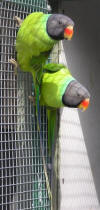. slaty headed parrot


Note: The Psittacula finschi, formerly listed as a sub-species of the Slaty headed parrot, is now listed as a separate species. The common name is the "Grey headed parrot/parakeet". Aviary Notes:Level Of Knowledge Required: Beginner / Intermediate / Advanced / Specialist Breeders Only. Government Regulations & By-Laws: Refer to " Government Laws " web page. Housing Requirements: Refer to " Housing Birds " web page for general details on the housing of Non Australian Parrots or read on for specific details for this parrot. Best housed as one pair per aviary. They need an aviary of about 4 - 5 metres long. They have strong beaks so a strong wire mesh is essential. 12 gauge is recommended but 14 gauge may be sufficient. They will destroy timbers and therefore a strong metal framed aviary is essential. Non-toxic leafy branches can be placed in the aviary for the birds to chew up. This will entertain the birds, help minimize boredom and give the birds some beak exercise. Natural branches can be used for perches. These natural perches will be chewed by the birds and may need to be replaced regularly. The birds will chew any flowers and fruiting bodies on the branches. Diet / Feeding: Refer to " Feeding Birds " web page for general details on the feeding of Non Australian Parrots or read on for specific details for this parrot. A good quality small parrot seed mix with added sunflower seed is recommended. Fruits including apple, orange, pear and grapes; vegetables including green leafy vegetables, corn-on-the-cob, peas and carrot. Greens such as chickweed, dandelion leaves and young green seeding dock "weed" plants can be offered. Seeding grasses, hawthorn berries and other berries (the ones people eat) are some favourites. Nesting: A basic overview only. Dimensions are typical / average and can vary widely, influenced by the owner's preferences and the birds preferences. Parent bird's preferences can also be influenced by the size and type of nest-box / log in which the bird was hatched and reared. If space allows, offering a choice of sizes and types of logs or nest-boxes, and placed in various locations within the aviary, can allow the parent birds to make their own choice. Once a pair has chosen a specific nest-box/log and been successful in it, offer that one to them each breeding season. Try and keep that one for their exclusive use. Once a pair has chosen its log or nest-box, the other ones can generally be removed. If the "spare" boxes are to be removed and moved to another flight, ensure the log / nest-box is cleaned to ensure the receptacle has the minimal contamination of mites, parasites and pathogens.
Timber nest-boxes generally require a climbing structure attached inside the box below the entrance hole. Both logs and nests need an entrance hole/opening of about 70 - 75 mm diameter and about 100 mm (about 4 inches) from the top. Many species of parrots like the entrance hole to be just big enough to squeeze through. More details on parrot nestboxes/logs and a selection of parrot nestbox/log photos can be found on the "nests", "parrot nests" and "parrot nestbox photos" web pages. Click on "Up" then "Nests" then "parrot nests" and "parrot nestbox photos" in the navigation bars. Breeding: Egg Colour White. Clutch/s per year .. usually 1, occasionally 2. Eggs per nest 4 - 5. Incubation approx 23 - 25 days. Fledge approx. 6 - 7 weeks. Independent approx. another 5 weeks. The hen is usually the dominant bird. Generally start breeding at about 3 years of age. New pairs should be introduced to each other several months prior to the start of the breeding season so the birds have plenty of time to establish a strong bond between each other. A good pair bond will usually result in better breeding results. The Slaty headed parrot will hybridize with the Plum headed Parrot. Fledgling Slaty headed and fledgling Plum headed parrots are almost identical so only purchase young birds from a reputable breeder or reputable bird dealer. The young are often left with the parent birds for a month or more and this will generally not cause any problems as the Slaty headed parrot usually only has a single clutch per year. The young birds will probably keep learning from the parent birds and benefit from the knowledge they learn. If aggression is observed the effected bird or birds should be immediately removed to another aviary. As with many parrots that are strong flyers, the inexperienced young can fly into the wire mesh at the open end of the aviary and this can cause injury or in the worst case, death of a bird. Placing leafy branches at the end of the aviary will minimize this problem. Artificial incubation and hand rearing or fostering will not be covered on this web site. It is too complex and diverse in nature to be attempted here. Health Issues: Refer to "Avian Health Issues" web page for information and references.
General References: Refer to references listed on "Book References" web page. Specific References:
|